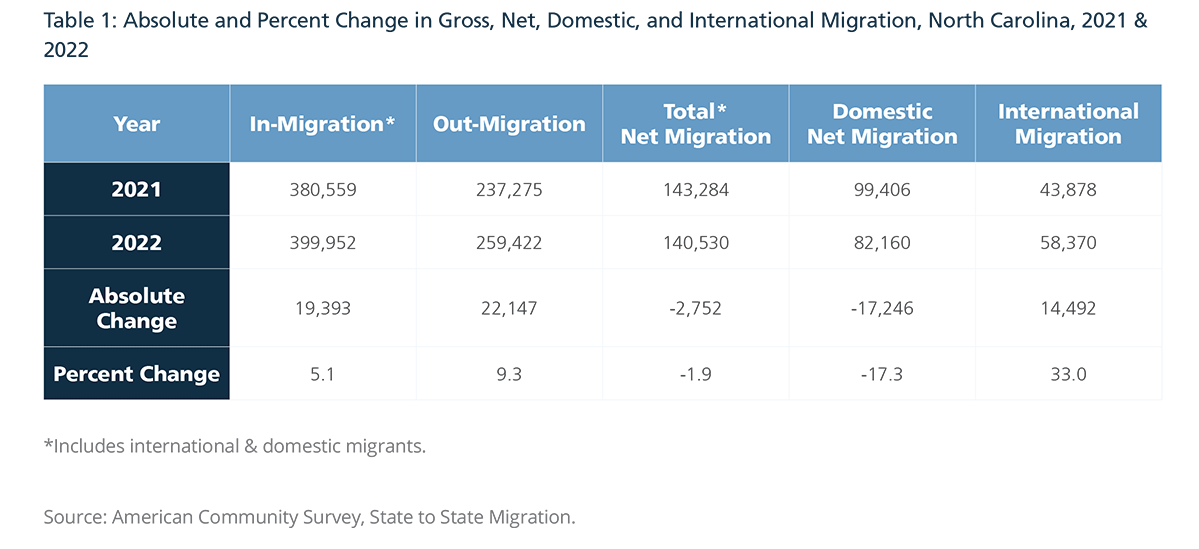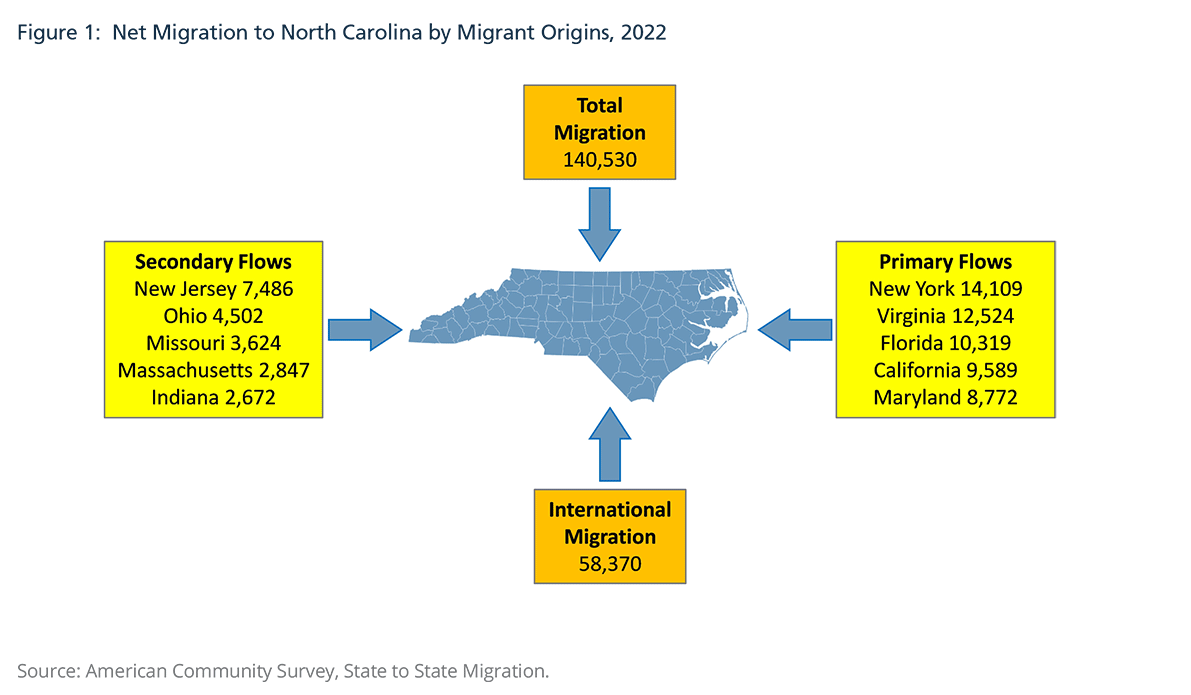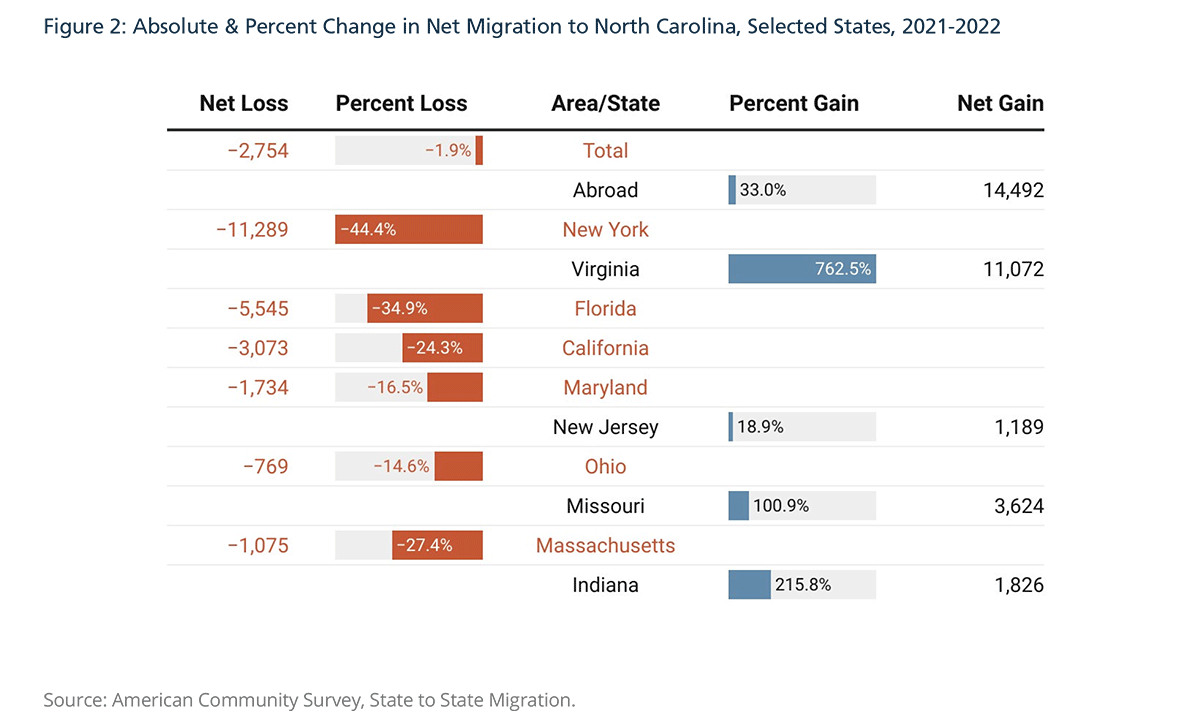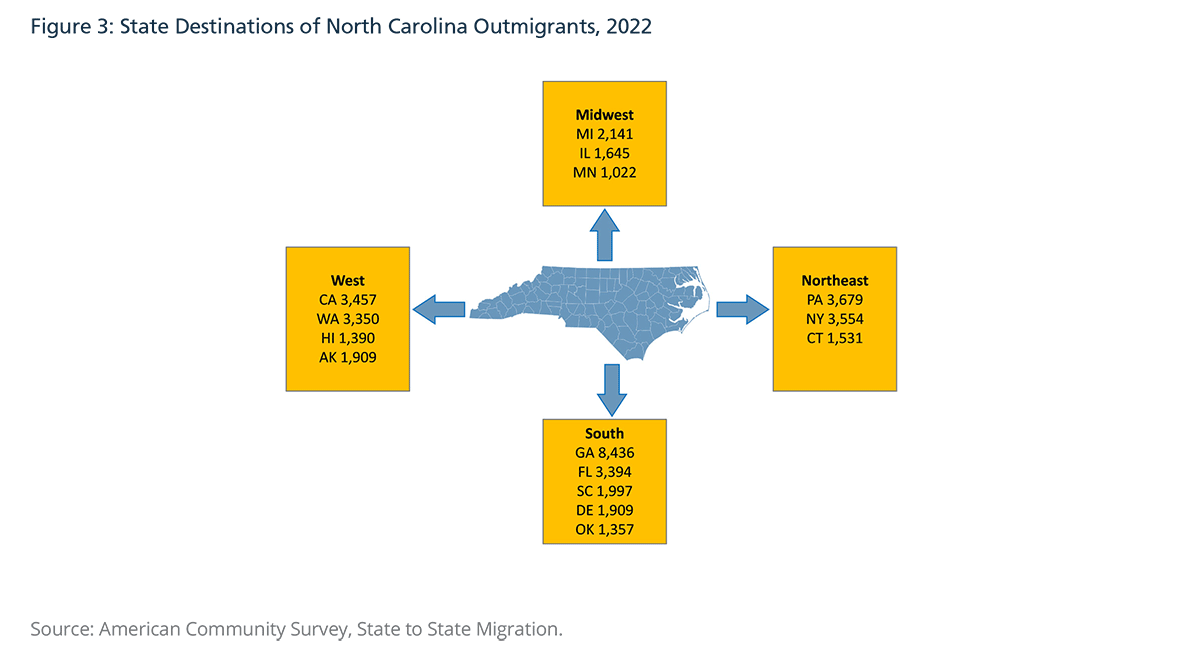Is North Carolina’s Attractiveness as a Migration Destination Waning?
White Paper by James H. Johnson Jr., Ph.D, Jeanne Milliken Bonds, MPA and Allan M. Parnell
Kenan-Flagler Business School UNC-Chapel Hill
November, 2023
ABSTRACT
In 2022, in-migration slowed, and out-migration accelerated, reducing the role of net migration in North Carolina statewide population growth, according to recently released Census data. For the Tarheel state, we document changes in gross and net migration flows between 2021 and 2022, highlight possible drivers, and offer anecdotal evidence as to why the revealed changes may foreshadow a longer-term shift in migration’s role in statewide population change. Only time—informed by additional data from the Census Bureau covering a longer period—will tell if we are witnessing a re-balancing after the COVID migration surge or a fundamental shift in North Carolina’s attractiveness as a domestic and international migration magnet.
Introduction
North Carolina has been one of the nation’s fastest growing states for several decades. The state’s population growth has been driven by net migration—more people moving to North Carolina than leaving—a trend that accelerated during the Covid-19 pandemic.
As we have documented elsewhere, thousands of people— individuals and families—fled large urban centers in the Northeast, Midwest, and West and relocated to small- and medium-sized towns and cities in the South and Mountain states during the pandemic. Dubbed pandemic refugees, they settled in less dense and mostly amenity rich places areas with a perceived lower risk of exposure to the deadly coronavirus and the necessary broadband infrastructure to support remote work.
In 2022, as Table 1 shows, North Carolina continued as a major destination for newcomers from both other states (341,582) and abroad (58,370), according to recently released state-to-state migration data from the U.S. Census Bureau. However, in both absolute and relative terms, outmigration (22,147) outpaced in-migration (19,393) in North Carolina between 2021 and 2022, reversing a pre-COVID 19 trend. As Table 1 shows, net migration declined by -1.9 percent during this period, resulting in -2,752 fewer net migrants in 2022 (140,530) than in 2021 (143,284).
Is this modest decline in net migration a cause for concern—a foreshadowing of future migration behavior? We think the answer may be yes. And here is why.
Ominous Trends
Following the COVID 19-mandated shutdown of the economy and international travel in 2020, international migration to North Carolina rebounded between 2021 (43,878) and 2022 (58,370), increasing by 33 percent or 14,492. Movers from abroad (58,370) accounted for 41
percent of the state’s net migration (140,530) in 2022. However, a sharp absolute decline in domestic movers to the state (-17,246) between 2021 and 2022 offset the net absolute gain in movers from abroad (14,492). In relative terms, net domestic migration in North Carolina declined by -17.3 percent during this period (Table 1).
Ten states, as Figure 1 shows, were principally responsible for net domestic in-migration, that is, interstate moves to North Carolina in 2022 (82,160). Net flows from New York (14,109), Virginia (12,524), Florida (10,319), California (9,589), and Maryland (8,772) accounted for close to seven out every ten newcomers to North Carolina in 2022 (67%). We define these as primary migration flows in Figure 1. Characterized as secondary flows in Figure 1, New Jersey (7,486), Ohio (4,502), Missouri (3,624), Massachusetts (2,824), and Indiana (2,672) rounded out the top net exporters of population to North Carolina in 2022, accounting for 26 percent of the net migration (21,108). Combined with movers from abroad (58,370), the net influx of transplants from these ten states (134,791) accounted for 96 percent of the migration induced population growth North Carolina experienced in 2022.
Signaling one cause for concern regarding the state’s future as one of the nation’s premier migration magnets, net migration slowed significantly between 2021 and 2022 in six of the ten states that served as major redistributors of population to the Tarheel state in 2022, as Figure 2 illustrates. Most notable, there were sharp absolute and relative declines in the net flows from New York (-44.4%), Florida (-34.9), and California (-24.3%) as well as Maryland (-16.5%), Ohio (-14.6%), and Massachusetts (-27.4%). Among the ten states, only four—Virginia (762%), New Jersey (18.9%), Missouri (101%), and Indiana (216%) –registered significant absolute and relative increases in net migration to North Carolina between 2021 and 2022. These state level changes in net flows from the primary and secondary redistributors of population to the state partly explain the modest slowdown in net migration to North Carolina between 2021 and 2022 (see Table 1).
Accelerated out-migration from North Carolina between 2021 and 2022 is yet another cause for concern. During this period, the absolute number of North Carolinians leaving the state increased more rapidly (9.3%) than the absolute number of transplants entering the state (5.1%) (see Table 1). As Figure 3 shows, there were significant absolute increases in the number of North Carolinians migrating to three states in the Northeast (Pennsylvania, New York, and Connecticut); three states in the Midwest (Illinois, Michigan, and Minnesota); five states in the South (Georgia, Florida, South Carolina, Delaware, and Oklahoma), and four states in the West (California, Washington, Hawaii, and Alaska).
With a net influx of 8,436, Georgia experienced the largest net absolute gain in the number of North Carolina transplants between 2021 and 2022. Pennsylvania, New York, California, Florida, and Washington State followed the Peach State. Each of these states reported net gains of between 3,300 and 3,700 North Carolina transplants between 2021 and 2022. And eight states benefited from net flows of between 1,000 and 2,200 North Carolinians during this period: Michigan, South Carolina, Alaska, Delaware, Illinois, Connecticut, Hawaii, Oklahoma, and Minnesota.
Possible Drivers
Systematic evidence regarding what is driving the slowdown in net in-migration to North Carolina and accelerated outmigration from the state is not yet available. However, for prospective migrants, anecdotal evidence suggests that the slowdown in net in-migration is driven, at least in part, by attractive intervening migration destinations between North Carolina and traditional sending communities like Florida.
Reportedly, many Floridians seeking to escape rising mortgage insurance costs due to repeated climate change-induced adverse weather events are moving to amenity-rich communities in Alabama, Arkanas, Georgia, Mississippi, Oklahoma and South Carolina instead of North Carolina. Other Floridians have been motivated to move to such communities by what they characterize as wealthy newcomers with bad attitudes and fancy cars—Rolls Royce’s, Range Rover’s, and Maserati’s—who have not only driven up the cost of housing, but also other
goods and services in Florida. Making matters worse, the newcomers reportedly are rude and disrespectful of longstanding community values and traditions—off putting tendencies for long-term Florida residents. According to media accounts, some long-term residents of impacted
communities like West Palm Beach, Florida have responded by selling their Florida residences, capitalizing on the pandemic-induced appreciated value of their homes, and moving to communities in nearby states (Alabama and Georgia, in particular) that are more affordable as well as inhabited by people who are more closely aligned with their individual and family values.
Interestingly enough, some of the same forces are, in all likelihood, driving accelerated outmigration from North Carolina, which was the third most attractive migration destination for pandemic refugees during the COVID crisis. Some North Carolinians, according to our focus group research, have been forced to leave the state due to escalating housing costs—an involuntary exodus caused in part by the in-migration trends over the past decade, combined with increasing interest rates and a shortage of housing stock. Others are voting with their feet after capitalizing on wealth accumulated in the sale of their home which allows them to relocate to their dream spot outside of the state.
Now that COVID-19 has subsided, return migration by some pandemic refugees to New York and other states in the Northeast as well as the Midwest and West, prompted by mandatory Return-To-Office policies, also likely contributed to the heightened outmigration from North Carolina between 2021 and 2022. Even a one or two day in office hybrid work policy requires employees to live closer to where they work.
And pulse polls and courageous conversation experiments conducted in a second year MBA class at UNC-Chapel Hill suggested that some of the students, upon graduation in 2021 and 2022, intentionally sought employment outside of North Carolina because they did not like the state’s political stance on culture war issues like reproductive rights and marriage equality. Reportedly, there has been a faculty and staff exodus from UNC System schools for similar reasons.
Concluding Thoughts
To be clear, we fully recognize that a single year of data does not constitute a trend. However, these data do raise questions regarding whether North Carolina will continue to remain a popular migration destination for newcomers from other states and whether accelerated outmigration observed over the past year will continue and, if so, why? We need answers to these questions given the state’s declining birth rate and sharp increase in deaths from chronic health conditions and substance abuse disorders
among prime working North Carolinians.
Elsewhere, our research has shown that, over the past three decades, these two vital trends—declining births and accelerated deaths—have contributed to slowing total population growth and created a demographic depression in the state’s workforce. Left unaddressed, these issues will adversely affect the competitiveness of our state, especially for future business development. Over the next several
years, new data will add insight into whether North Carolina is facing significant economic challenges reflected in the patterns of out-migration or if we are re-balancing after the Covid migration surge.
About the Authors
James H. Johnson, Jr. is the William Rand Kenan, Jr. Distinguished Professor of Strategy and Entrepreneurship in the Kenan-Flagler Business School and Director of the Urban Investment Strategies Center in the Frank Hawkins Kenan Institute of Private Enterprise at UNC-Chapel Hill.
Jeanne Milliken Bonds is a Professor of the Practice, Impact Investment and Sustainable Finance in the Kenan-Flagler Business School and the Department of Public Policy at UNC-Chapel Hill.
Allan M. Parnell is a Senior Research in the Kenan Institute’s Urban Investment Strategies Center and Vice President of the Mebane, NC-based Cedar Grove Institute for Sustainable Communities.
The Kenan Institute serves as a national center for scholarly research, joint exploration of issues, and course development with the principal theme of preservation, encouragement, and understanding of private enterprise.
Related Articles
North Carolina at a Demographic Crossroad: Loss of Lives and the Impact
North Carolina at a Demographic Crossroad:Loss of Lives and the ImpactNorth Carolina’s phenomenal migration-driven population growth masks a troubling trend: high rates of death and dying prematurely which, left unchecked, can potentially derail the state’s economic...
WILL HURRICANE IAN TRIGGER CLIMATE REFUGEE MIGRATION FROM FLORIDA
Will Hurricane Ian Trigger Climate Refugee Migration from Florida?Thirteen of Florida’s counties were declared eligible for federal disaster relief following Hurricane Ian’s disastrous trek through the state (The White House, 2022). The human toll and economic impact...
North Carolina after the Pandemic: A Model for Creating a Successful Business Ecosystem for All
As a magnet for both population and employment growth, North Carolina has a propitious opportunity to create an inclusive and equitable entrepreneurial and small business ecosystem to support the state’s newfound prosperity. Leveraging qualitative insights from key informant interviews with government officials, community leaders, and minority entrepreneurs in one of the state’s hot spots for growth, we outline the major parameters of a place-based approach to creating an inclusive entrepreneurship and small business ecosystem that generates shared prosperity, eliminating in the process longstanding inequities in community economic development in the state.












